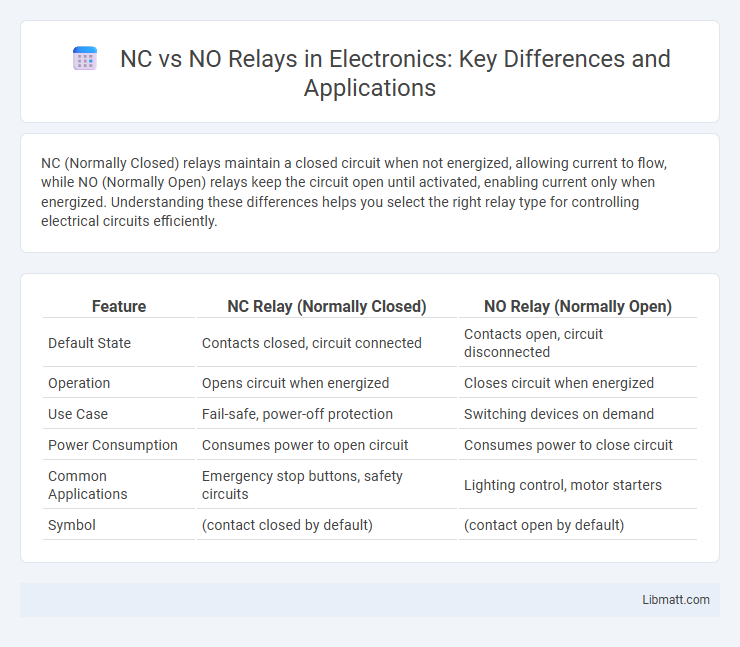NC (Normally Closed) relays maintain a closed circuit when not energized, allowing current to flow, while NO (Normally Open) relays keep the circuit open until activated, enabling current only when energized. Understanding these differences helps you select the right relay type for controlling electrical circuits efficiently.
Table of Comparison
| Feature | NC Relay (Normally Closed) | NO Relay (Normally Open) |
|---|---|---|
| Default State | Contacts closed, circuit connected | Contacts open, circuit disconnected |
| Operation | Opens circuit when energized | Closes circuit when energized |
| Use Case | Fail-safe, power-off protection | Switching devices on demand |
| Power Consumption | Consumes power to open circuit | Consumes power to close circuit |
| Common Applications | Emergency stop buttons, safety circuits | Lighting control, motor starters |
| Symbol | (contact closed by default) | (contact open by default) |
Introduction to Relays: NC vs NO
NC (Normally Closed) and NO (Normally Open) relays are essential components used to control electrical circuits by switching connections based on coil activation. An NC relay maintains a closed circuit when de-energized, allowing current to flow continuously, while an NO relay keeps the circuit open and only closes it when energized, interrupting current flow until triggered. Understanding the difference between NC and NO relays helps you design effective control systems tailored to specific operational requirements and safety protocols.
What is an NC (Normally Closed) Relay?
An NC (Normally Closed) relay is an electromagnetic switch with a contact that remains closed when the relay coil is not energized, allowing current to flow continuously through the circuit. When the coil is energized, the contact opens, interrupting the current flow to control electrical devices. NC relays are commonly used in safety and fail-safe applications where maintaining circuit continuity during power loss is critical.
What is an NO (Normally Open) Relay?
An NO (Normally Open) relay is an electromagnetic switch that remains open when inactive, allowing no current to pass through its contacts. When energized, the relay closes the circuit, enabling current flow and activating your connected device. This type of relay is commonly used in applications where a circuit should only be completed under specific conditions.
Key Differences Between NC and NO Relays
NC (Normally Closed) relays maintain a closed circuit when de-energized, allowing current to flow by default, whereas NO (Normally Open) relays keep the circuit open until energized, enabling current only when activated. Your choice depends on whether you need the circuit to be active without power (NC) or only when the relay is powered (NO). These key differences impact control logic and fail-safe design in automation and electrical systems.
Working Principles of NC and NO Relays
NC (Normally Closed) relays maintain a closed circuit when de-energized, allowing current flow until the coil is energized, which opens the contacts and interrupts the circuit. NO (Normally Open) relays keep the contacts open in the de-energized state, preventing current flow until the coil is powered, causing the contacts to close and complete the circuit. Both relays operate using an electromagnetic coil that moves a switch to change the state of the contacts based on whether the coil is energized or not.
Common Applications of NC Relays
NC (Normally Closed) relays are commonly used in safety and fail-safe applications, such as emergency stop circuits where the circuit must remain closed to ensure continuous operation or safe shutdown. They are also ideal for power backup systems and alarm circuits, ensuring that power or a signal flows by default and only interrupts under specific conditions. Your automation systems benefit from NC relays when immediate disconnection during fault detection is critical for safety and functionality.
Common Applications of NO Relays
NO (Normally Open) relays are widely used in applications where circuits need to be activated only when required, such as in lighting control systems, alarm systems, and automotive starters. These relays are ideal for switching devices on momentarily, ensuring safety and energy efficiency by completing the circuit only upon activation. Your automation projects benefit from NO relays' reliable operation in controlling pumps, motors, and other electrical appliances that require timely and precise engagement.
How to Choose Between NC and NO Relays
Choosing between NC (Normally Closed) and NO (Normally Open) relays depends on the specific control logic and safety requirements of your circuit. NC relays are ideal for fail-safe operations where the circuit must remain closed without power, while NO relays suit applications requiring circuit activation only when energized. Assessing load conditions, response time, and the default state needed in power loss scenarios ensures optimal relay selection for reliable performance.
Advantages and Disadvantages of NC vs NO Relays
NC (Normally Closed) relays provide continuous circuit connection when de-energized, offering fail-safe operation during power loss, ideal for safety systems; however, they may cause unwanted power consumption in some applications. NO (Normally Open) relays remain disconnected until energized, reducing energy use and preventing circuit activation in default states, yet they risk system failures if not energized properly during critical operations. Your choice depends on balancing reliability and energy efficiency requirements specific to your control system.
Conclusion: Selecting the Right Relay for Your Project
Choosing between NC (Normally Closed) and NO (Normally Open) relays depends on your project's specific control requirements and safety considerations. NC relays provide a default closed circuit that opens when activated, ideal for fail-safe applications, while NO relays offer a default open circuit that closes upon activation, suitable for triggering devices only when needed. Your selection should prioritize reliability in the intended operating environment and the desired default state to ensure optimal performance and safety.
NC vs NO relay Infographic

 libmatt.com
libmatt.com